Before we get started this week, I’d like to welcome two new additions to our crew of comic pillagers: Bart Bishop and D.S. Randlett are going to help us expand our comics coverage, and both of them are firing on all six (or some suitable Viking metaphor) in their first week on the team.
Enjoy!
Wolverine And The X-Men #1 (Marvel Comics, $3.99)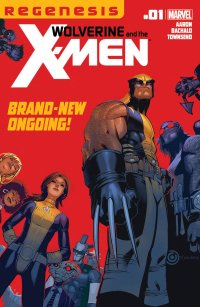
By Devon Sanders
Following the events of Schism, we get a… schism, resulting in the fracturing of The X-Men taking the sides of either Wolverine or Cyclops; both X-Men mainstays. Cyclops has always been the stoic; quietly leading his team by example and by the pacifistic way of his longtime mentor, Charles Xavier.
Wolverine has always been Wolverine.
Wolverine comes and goes as he please. Not that great at taking orders, drinking, riding motorcycles in cowboy hats; doing whatever it is writers think is cool at the time. Never the leader but one hell of a soldier, Wolverine has almost always been the center of The X-Men, if not the ideal.
A funny thing happened, though. Somewhere between the mutant massacres, civil wars, secret invasions and sieges; Wolverine became respectable. He became a member, in good standing, of two Avengers teams. He became a trusted confidante to multiple young mutants and various heroes while Cyclops grew darker, taking up with former X-Men enemy, Emma Frost; allying himself and The X-Men with Magneto and Namor, The Sub-Mariner. Did I mention Cyclops created his own death squad with a 15 year old on the team? No? Well, somewhere in there Wolverine became Charles Xavier’s dream; a mutant living openly and proudly. A member of The Avengers, standing shoulder-to-shoulder with Captain America, Thor and Iron Man.
It had to end.
Enter Wolverine and The X-Men #1.
The X-Men have splintered, with Wolverine taking X-Men Kitty Pryde, Iceman, Rogue, Gambit, The Beast and a cast of young mutants back to the grounds of The Xavier School For Gifted Youngster; now re-titled bearing the name of the late Jean Grey. Things are off to a rocky start as the New York school board visits, making sure the school itself is as safe as a school known for Sentinel attacks can be. A young boy approaches the gates of the institute with a promise and all hell breaks loose. Welcome to your first day as headmistress of The Jean Grey School For Gifted Youngsters, Kitty Pryde. Hope you survive the experience!
Writer Jason Aaron has put together something I’m more than willing to come back and revisit. The first issue comes is a bit crowded with introductions designed to give every character a moment and it ultimately does its job. The true and I believe tone of the book is set fairly late in the story and shows tons of potential, leading to what I hope, could become one of the more interesting storylines in years.
Artist Chris Bachalo has always been a favorite of mine, there’s a dynamicism to his fat chunky line that I’ve always liked. It’s his page layouts I’ve sometimes had issues with. Well, this time around a more well-rounded Bachalo is on display. Bachalo perfectly captures the wonder of this new, bright thing Wolverine’s put together while doing some beautiful figure work.
Wolverine And The X-Men #1 is a fun, interesting book; the perfect culmination of where Wolverine and better yet, The X-Men, can and should be.
Rating: 




Out of a Possible 5 Stars
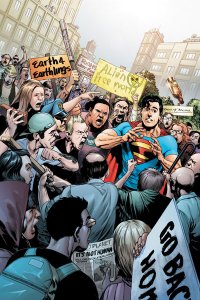 Action Comics #3 (DC Comics, $3.99)
Action Comics #3 (DC Comics, $3.99)
By D. S. Randlett
It’s hard to say exactly when Superman’s latest identity crisis (the kind not involving rape) began. Was it during the Death of Superman storyline? Was it during Infinite Crisis? I can’t exactly say, but it’s been clear for a while now that the foundation John Byrne established in the eighties has run out of gas. So where to go from here? If the last couple of months have been any indication, we’ve walked right into another identity crisis. Not one where an interpretation has run out of steam, but one where creators across the Superman line have been struggling to find a new voice for the character.
I think these concerns can be alleviated somewhat, for Action Comics at least. The series’ third issue slows down the action a bit, with the breathless pacing coming in the form of wit rather than stunts. We see more of Clark Kent here than we have in any of the Super titles thus far, and it’s a fun interpretation. Kent’s not so mild mannered as he’s been in the past: he’s a little more relentless, and I like that he’s not using his privileged position to scoop everybody on Superman stories. He’s pursuing issues that matter to him (he seems to be modeled on someone like a post-financial crisis Matt Taibbi) and it’s a great touch. Meanwhile, Superman’s first “foe”, a revitalized Glenmorgan, is turning his media empire – and the public – against Superman.
The series’ themes seem to be developing rather nicely, too. If the first issue was an initial burst of populist energy, the second was the authoritarian clamp down. In this third issue, the elites are turning the very people Superman saved in the first issue against him. It’s Superman having his TEA Party moment, essentially.
The second issue of this series had a hard time living up to the breathlessness of the first, and the third doesn’t even really try. What it does instead is focus on humor and character, which is a welcome change of pace for this title. Gene Ha brings a dose of nobility to his portrayal of Krypton in the opening sequence, and provides a nice counterpoint to Rags Morales’ rough ‘n tumble style for the world “here below” throughout the rest of the issue.
Rating: 




Out of a Possible 5 Stars
Animal Man #3 (DC Comics, $2.99)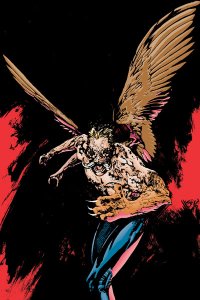
By Bart Bishop
Buddy Baker and his family have seen better days. Written by Jeff Lemire (Frankenstein: Agent of S.H.A.D.E), Animal Man #3 marks the halfway point in the first story arc of the revitalized series. At last issue’s end, Buddy and his daughter Maxine had followed the path of Buddy’s newly manifested tattoos into the “Life Web” and arrived at the Tree at the center of the web. This is all a part of The Red, the fleshy counterpart to Swamp Thing’s The Green (which, I believe, was introduced during Andy Diggle’s run on the short lived Swamp Thing v. 4 from 2004).
This issue picks up with Buddy and Maxine entering the Tree to meet the Totems, Cthulhu-esque beings that are the equivalent of the Parliament of Trees to the Green. Kudos to artist Travel Foreman who really shines in these sequences; he brings a bizarre sense of creativity and Otherness, an almost Baroque sense of movement and fascination with flesh and the human form. Another word, however, on his human forms: although I appreciate his lithe depictions of human beings and everyone having a distinct body shape, the overusage of shading and heavy inking can be offputting. Buddy, in particular, has indecipherable expressions at times, and his “Life Web” tattoos are indistinguishable from the linework on his body.
So far this series has been a New 52 high point. Lemire understands Buddy’s voice, continuing where Grant Morrison left off but adding contemporary layers of angst and listlessness. Morrison’s Buddy wanted desperately to be a member of Justice League Europe; this Buddy is a superhero more as a hobby and is considering alternatives. What the (re)introduction of the Red and the machinations of the Totems and the Hunters Three ensure is a Buddy with a clear purpose and threat to oppose.
A note on that purpose: I am so tired of the concept of the Chosen One. Scott Snyder has been playing around with Holland as Chosen One over in Swamp Thing, and Lemire is doing it here. It’s especially pronounced here considering both series are dealing with similar concepts (of the Rot). I understand that Lemire has to deal with Buddy being a second-tier character, and the threats introduced here are exlusively his speciality, but why did it have to be destiny?
There’s an especially unnecessary bit of retconning dealing with Buddy’s origin in order to frame the character as a Chosen One. I wasn’t enamored of the alien origin, but the execution of the reveal as throw-away dialogue (without a prior recapping of the origin of Buddy’s powers in this issue or the last two) comes across as lazy afterthought. This is an issue in which half is dealing with exposition, but the Everything-You-Know-Is-A-Lie elements on display reek of shame at the concept of superheroes.
Yes, this comic has spent three issues establishing a horror narrative within a superhero universe, but it also has a sense of whimsy, awe, and even cuteness (the Bakers are adorable, admit it). Why shy away from embracing the silliness of aliens? Now the world feels a little smaller, and Buddy has become yet another in a long line of heroes that won’t win through nobility or force of will, but because they were meant to win. There’s an element of Cronenbergian “Body Horror” at work here, as the Hunters Three not only assimilate and use the flesh of their victims but Buddy himself is torn apart and, by the end, reshaped into something wholly new. That’s where Lemire shines, as he makes his audience feel the foreignness of Buddy’s powers and the truly ancient, unknowable evil that the Rot represents.
I haven’t read anything like this in a while, and I’m happy to say I’m in it for the long haul.
Rating: 




Out of a Possible 5 Stars
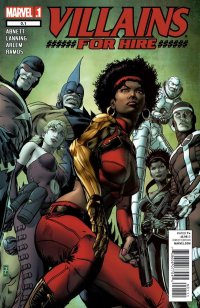 Villains For Hire #0.1 (of 4)(Marvel, $2.99)
Villains For Hire #0.1 (of 4)(Marvel, $2.99)by Graig Kent
I’m fairly certain that, had I more time to just hang around my local comics shoppe like I did as a teenager (15 – 20 years ago!), I would have, in the past year, participated in the grammatically incorrect conversation of “who’s better, Birds of Prey or Heroes for Hire“. Of course, being a decades-long DCer I would have sided with Oracle, Black Canary and company. However, I wonder if I would conceal or reveal my ignorance in regards to Misty Knight’s little mercenary operation? Because I am, indeed, ignorant. Villains For Hire, by all accounts, may be my first in-story exposure to Miss Knight. I’ve known of her, but I don’t know her and I don’t really know anything about Heroes For Hire (wasn’t it founded by Power Man and Iron Fist?).
This is a “Marvel-point-one” issue, meaning it’s intending to be a great “hop on board” issue for new readers who haven’t been regular readers, though I’m curious if this is the first “point one” issue preceding a mini-series, which seems kind of unnecessary (why not just number it “Issue 1?”). As a “point one” issue I was expecting more in the way of introduction, of “what’s come before” and there’s not so much of that here, but it’s also not terribly necessary for the story-at-hand. It’s a pretty zippy little story about wrangled heroes-for-hire (Silver Sable, Black Panther, Paladin, Hellstrom) squaring off against wrangled villains-for-hire (Stilt-Man, mole men, Sidewinder), with the ultimate reveal that Misty Knight has a competitor on the other end of the “for hire” spectrum.
It’s a simple enough concept, and old pros Dan Abnett and Andy Lanning approach it straight on, with entertaining action, strong dialogue, piles of spandex and a brewing larger conflict. Renato Arlem isn’t called upon to do anything unusual for an action-oriented comic, so it comes across as an old school romp of fights and tights. It looks good, and it goes down easy. My biggest problem with the book was indeed my own, in that I couldn’t separate Misty from Oracle, as she’s playing pretty much the same role, only with bigger hair and more cleavage.
Rating: 




Out of a Possible 5 Stars
All Fall Down (Arcana Studios, $19.95)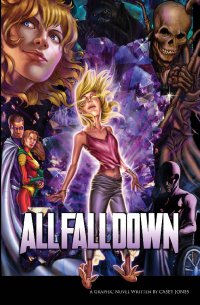
By Jeb D.
Writer Casey Jones’ original graphic novel is an example of catharsis through art: its impetus was the tragic death of his friend’s sister, a story he works out metaphorically in All Fall Down. The book even succeeds as meta-commentary, as he lost the chance to have the story adapted into a film when he resisted the studio’s request that he give it a more upbeat ending, driving home its message of the random unfairness that plagues our lives. On a more specifically comic-book level, though, it also provides an interesting sort of “reverse example” of how the Big 2 universes continue to hang on.
In a world where there are 600 super-powered people—
OK, let’s just stop right there. Over the decades, the DC and Marvel universes have metastasized into the homes of vast armies of people flying, running, lifting, punching, and performing all manner of spandexed activity. A glance at any of the various Guides or Encyclopedias to them that have been published over the years suggests that 600 super-powered characters is probably something of an understatement. But these “universes” grew slowly, gradually. Superman wasn’t created with his own dog, horse, or Arctic fortress, and the cast of characters that surround him and his peers was built up over the course of decades; readers who want to read the adventures of Big Blue get gradually eased into the idea of a world inhabited by a plethora of godlike beings, but looking more or less like our own.
That’s one reason that the Big 2 continue to soldier on while Reddy-Bilt™ superhero universes from other publishers crash and burn (or die whimpering): the “world-building” so necessary to this kind of storytelling was done back when comics were cheap and millions of people read them, making them a sort of lingua franca, so that even the newest reader comes in knowing the key players. The idea of slapping together an instant superhero environment, and expecting the same buy-in from readers rarely succeeds. What happens is that the proliferation of super-beings, which we’ve come to take for granted in the established universes, just looks odd. Instead of following the story, you start asking yourself why a planet with hundreds of these weirdos looks and behaves pretty much like our own, and wonder about the larger ramifications of the super-population instead of the nominal protagonists of the story at hand.
And while building a superhero universe isn’t the principal focus of this book (actually, focus is a bit of an issue, but more of that anon), it’s structured in such a way that Jones is trying to trade on the empathy that longtime fans have for their favorite Flash or Captain America, or what have you. We get the usual analogs here (speedster, hulking Thingy-monster); recast the roles with Barry Allen or Ben Grimm and your work is half-done already. But while Jones wants you to bring the same reactions and emotions that you’d get reading about The Flash, instead, you just sort of nod to the construction of the archetype; when things go badly for him, you’re only involved to the extent that it furthers the plot.
That plot has the makings of a good one: one day, all the super-beings suddenly, mysteriously, lose their powers, with all manner of tragic consequences. Even more mysteriously, those powers have manifested themselves all in one teenage girl, Sophie Mitchell, who adopts the identity of “Siphon,” reflecting her Rogue-like acquisition of the powers, attempting to pick up the slack from the fallen heroes.
Sophie is our nominal protagonist, and her tale of power and responsibility, as it were, would actually have made the kind of nicely-laid-out storyline that would adapt well for film, as she deals with the consequences of her unwanted “gift.” Unfortunately, she’s actually less a protagonist than she is a Macguffin. Because the real engine of the story is not Sophie, or the various other supers whose lives were affected by the event (the fate of the shape-shfting Phylum is particularly creepy), or even the Ghost Rider-headed vigilante who goes around thrashing the nonpowered “wannabe” heroes that spring up in the wake of the depowering; it’s actually the strained relationship between the son of an old-school supervillain and his father (you can tell that Dad was old-school cuz he tawks like a vet of the New Yawk mob scene… or maybe the garment district). I won’t get too spoilery or specific about this part of the story, and the scheme that the son initiates, which has several nice touches (I like the fact that his advanced technology was constructed while he had super-intellect, and while he can still use the devices that he built then, he can’t go beyond them), though the father-son conflict feels a bit strained and artificial. Which, in a way, isn’t really surprising: it’s Sophie’s story that was supposed to be at the heart of this, and this conflict, along with the usual betrayals and big reveals, are too often a distraction from it. I wonder if maybe a stronger editorial hand might have allowed the book to more effectively balance its various characters and plotlines.
But for all its structural flaws, it’s a story that we haven’t seen before (at least not all of its elements), and when it focuses on Sophie, the emotion that drove Jones to create it in the first place positively glows.
I’m less enthused about the art. Each of the six chapters is drawn by a different artist, and most of them (including Jason Reeves and Gian Fernando) still appear to be in their formative period, with anatomical consistency a bit of a struggle. Chapter Five stands out significantly from the rest—Pericles Junior’s work has a very professional look to it, and you could almost imagine him (her?) taking on something like an X book right now—but that unfortunately just reinforces the awkwardness of much of the rest of the art, impeding the story’s flow.
Despite my reservations, I recommend All Fall Down: the structural and artistic inconsistencies are annoying, but in the end, the strength of Sophie’s story carries the emotional weight to prop up the occasional sag.
Rating: 




Out of a Possible 5 Stars
 Heart #1 (Image Comics, $2.99)
Heart #1 (Image Comics, $2.99)
By D.S. Randlett
In Blair Butler and Kevin Mellon’s “Heart”, we seem to be getting a story from the recession. While unemployment and inequality are unaddressed, this story feels authentically of the world as it’s been in the lead up to and during that chain of events, and the question that the main character (one Oren Redmond) faces is one common to a lot of young adults during hard times: How do I forge an identity in an inhospitable world? Oren finds an answer in the world of MMA. But is that enough for him?
If Heart gets anything right, it’s portraying the experience of a fight and the experience of being an athlete. The opening section of the book gets right down to it, and the fight feels like a doozy, even though the characters aren’t throwing trains at one another. There’s an authenticity to the action here that you don’t find in a lot of other “fight” comics. Butler and Mellon seem to understand what makes sport – combat or no – so enjoyable: rhythm and momentum, and that comes through here in the action storytelling.
When we’re not in the ring, we’re focused on Oren’s journey to it. He seems like many twenty somethings that you meet in this day and age: he wants to make something of himself, but he doesn’t have very many outlets for his ambition. If readers won’t identify with his exact path, they’ll damn sure identify with the sentiments expressed.
For now, this story seems like it might shake out like one might expect from a sports story, but it does have enough seeds in its premise to perhaps yield something different. Oren’s remaining doubts about his life choices are a compelling spin you don’t typically see in the sports genre. His liberation through the sport appears partial at best, and maybe even illusory.
“Heart” is a solid story executed solidly with the potential for more, and I look forward to what the next three issues will bring. Put on some Social Distortion and give it a shot.
Rating: 




Out of a Possible 5 Stars
Star Wars: Crimson Empire III: Empire Lost #1 (Dark Horse Comics, $3.50)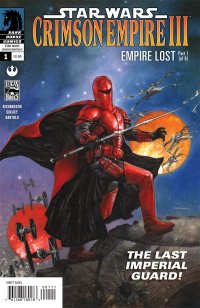
By Bart Bishop
I have a confession to make: I’m a recovering Star Wars fan. I’m about two years sober, having made a conscious decision to abstain. It’s not that I hate the franchise, I’m just oversaturated with the constant debate and re-releases. I figure with time and distance, maybe some day I can watch the movies again like it’s the first time. What Crimson Empire represents for me, however, is a time before the prequels and the saturation.
Crimson Empire was published by Dark Horse Comics in 1997 and 1998, a six issue mini-series that introduced Kir Kanos, the last survivor of the Imperial Guard. You’ll remember them as the red armored guys from the Emperor’s throne room in Revenge of the Sith and Return of the Jedi. Kanos is a Man-With-No-Name archetype, comparatible to Boba Fett but with less of a shell. Although he’s sworn to kill Luke Skywalker, his drive is honorable and competence admirable, as is his cocksure attitude.
This vendetta against the Jedi Master continued into the sequel, Crimson Empire II: Council of Blood, which was published in 1998 and 1999, on the cusp of the release of The Phantom Menace. Star Wars fever had already been ramping up due to the release of the Special Editions, but it thereafter reached a fever pitch that lasts to this day. With Kanos and Skywalker never having met in person, it seemed a certainty that (in grand Star Wars tradition) there would be a trilogy capper.
Originally planned for a release in 2001 and then 2002, then 2008, now it’s finally been released. Needless to say there’s been anticipation on my part, as this is practically the only thing (besides an official Knights of the Old Republic 3) that could get me excited about Star Wars again. Written by Dark Horse Comics’ President and Vice President, Mike Richardson and Randy Stradley (issue # 86 of Marvel’s Star Wars series, published in 1984, was in fact his first published comic), Crimson Empire III is old hat for them as they return to what they started.
Set thirteen years after the Battle of Yavin (the events of A New Hope), this is firmly within the New Republic Era. Luke has founded a Jedi Academy on Yavin IV, Leia is the President of the New Republic and has three kids with Han, and Chewie isn’t dead yet. Basically this is the original troup in their prime, and this is my favorite Star Wars era (which includes The Thrawn trilogy of books and Dark Empire comics).
With the scene set, how is the comic itself after twelve years of waiting? Frustrating, to say the last. The opening two pages remind me of how overwhelming it is to engage the Star Wars Expanded Universe: a recap page, including a description of the New Republic era, and a scroll reminiscent of the movies. Rather than bring new readers up to speed, say a young kid having just watched the newly released Blu-Rays for the first time, all this continuity intimidates and overwhelms.
The plot itself, however, is straight forward. A ship pursues a Tie Fighter towards an unkwown planet (a sequence that has a Captain pondering in thought bubbles, which unfortunately feels quaint in 2011); Kir Kanos prowls the mean streets of…some planet, taking out fools; Leia deals with politics and is introduced to new character Lieutenant Ndigo, who looks more like Luke Skywalker than Luke Skywalker as depicted by artist Paul Gulacy; and Luke trains Jedi on Yavin IV. There’s a definite feel of in medias res, which Star Wars is known for, but the whole issue feels off somehow.
Take, for instance, the aforementioned artwork. It’s perfectly workmanlike and suitably faithful to the movies, but is stilted and lacks energy. The panel layout from page to page is repetitive, with each page divided into three sections that lends itself to clean but dry storytelling. The faces are rather stiff, with characters looking plastic, complete with dolls’ eyes. Where’s the dynamic choreography of the earlier volumes, such as a classic scene when Kanos shoots a Tie Fighter out of the sky with just a blaster? Where’s the sense of wonder at exotic locales and alien species? Hallways appear claustrophobic, which doesn’t lend authenticity to a galaxy far, far away.
Finally, the dialogue lacks jazz or punch. The original trilogy was a swashbuckling adventure, and there was a gee-whiz sense of fun to the snappy one-liners. Here the characters are deadly serious, whether they’re discussing Jedi sword fighting tactics, politics, or the resurgence of an Empire. No one, except for a brief appearance by the Solo children (with whom I bring my own baggage, being aware of their ultimate fates, although that’s no fault of this story), is happy to be here. Original characters created by Richardson and Stradley, like Kanos and Mirith Sinn, come across as Mary Sues while the movie characters’ voices haven’t quite been captured.
A few choice cameos and nods to fans make for an enjoyable experience, and the action and intrigue are enough to bring me back for a second issue, but it’ll have to be an impressive second issue. At the very least the painted covers will make sweet posters.
Rating: 




Out of a Possible 5 Stars
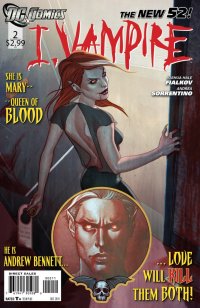 I, Vampire #2 (DC Comics, $2.99)
I, Vampire #2 (DC Comics, $2.99)by Graig Kent
One look at the cover of I, Vampire #1 back in mid-July and I firmly balked. If you haven’t seen it, it’s a rather plain, (I’m guessing) digitally painted cover by Jenny Frison featuring a full-body shot of a nearly-nude female vampire and a jeans-only male vamp standing backs half-turned in opposition to one another. It seemed, let’s face it, like a poor Twilight knock-off, and it certainly wasn’t connecting with the 30-something male comics-reading demographic. I had absolutely no desire to read what was beneath that cover, and continued to balk at its existence up until its release, even going so far as to predict its cancellation within its first year. I mean, who wants to read yet another bloody (no pun intended) vampire love story?
As it turns out, I do.
After receiving a strong recommendation from my comic shop owner, and spying a few favorable reviews noting not to judge the book by its cover I gave it a shot, and I think it’s easily the most underrated and unsuspecting book in the new 52. I still predict it won’t last long, mostly because I don’t think enough people are going to catch onto it in time to save it from cancellation, but from an exceptionally strong first issue to an equally strong follow-up buzz should keep growing and I’m firmly behind it.
I, Vampire is indeed a love story, but also a war story, and a moody, gruesome horror that makes a lot of the more action-oriented vampire tales (Underworld series, Blade trilogy, Daybreakers) seem kind of fluffy in comparison. Joshua Hale Fialkov has been a guarded secret in the comics industry for years since his attention-getting indie series Elk’s Run ended. He’s been working but not nearly to the profile his talent suggests. He’s got his first ongoing series break here with the big two and even though he’s not doing superheroes (at least not just yet) he’s steps away from blowing up, joining the likes of Jonathan Hickman, Jeff Lemire, Nick Spencer and Cullen Bunn who are being recognized for their quality creator owned work and given some leeway in establishing their unique voice in the mainstream.
Here Fialkov is expertly navigating a tragic romance between two vampires who have diametrically opposing ideologies. Mary, Queen of Blood is gearing up a vampire army for the wholesale takeover of Earth from mankind, while Andrew Bennett, the most dangerous vampire “alive”, is out to stop her. It’s kind of a Buffy/Angel thing, but so much bloodier, with more skewering, lopping and gashing and piles and piles of bodies. Fialkov, in the first two issues, has built a convincingly scary (if still a little generic) underworld in the DCU, one that can cause tremendous chaos when allowed to spill out onto the streets in force, but its his lead characters that are more put into focus. Andrew Bennett was more the focus of the first issue, Mary the second, and it would be a very interesting structure for the series if it were to continue to alternate as such. Fialkov’s vampires, meanwhile, take a step back into more of the folklore-ish territory, able to transform into mist, wolves, bats, and rats, though it’s obvious that Andrew Bennett has the most experience doing so (there is a tremendous fight sequence showcasing his ability).
The art is handled by Andrea Sorrentino with obvious comparisons to Jae Lee’s technique, thus still on the path toward forging his own distinct style. Sorrentino’s inks are black and heavy with razor-thin lines slashing across the white spaces, making it simultaneously heavy and weightless at the same time. The use of that negative space certainly sets a mood. Colorist Marcelo Maiolo wisely keeps a reserved color palette of grays, browns and reds, though I’m not sure color is even a necessity on this book. I’m curious as to what the straight B&W art looks like.
As I noted, this is a heavy vampire horror book but set squarely amidst the DCU. The actions of the first two issues aren’t going to remain unnoticed and it’ll be interesting to see how Fialkov incorporates the tights and capes into the blood and teeth while still retaining it’s chill. While I was two steps away from being done with vampires (they’re as overexposed as zombies) I, Vampire has found a way to keep me interested, in spite of its covers.
Rating: 




Out of a Possible 5 Stars
Peanuts #0 (Kaboom!, $1.00)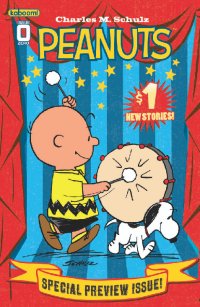
By Jeb D.
Charles Schulz was a genius. A kind, god-fearing gentleman of the old school, he brought a lifetime’s worth of incomprehending rage at the world’s unfairness to the comics page, and spent a career attempting to make sense of a loving deity that would stand by and watch. The very first Peanuts strip has Patty (not the Peppermint one) tally up some of the better qualities of “good ol’ Charlie Brown,” before flatly concluding “I hate him,” which vies with Rousseau or Locke as an observation on the conundrum of the human condition. Through his spookily mature kids (and Snoopy, who became a delightfully self-aware mashup of Ariel and Caliban, among other things), Schulz broke new ground in terms of what a humor strip could offer. He was also one of the funniest mofos ever to grace American letters.
The gentler side of the humor of Peanuts was always the easiest part of the strip to extract, and on the heels of the transformative 1964 success of its first Christmas TV cartoon, Peanuts exploded as a merchandising machine. While none of that ever diluted the strip itself (some of Schulz’ best work was done well into the 70’s), it set the tone for pop culture mass-merchandising on a level that only Walt Disney had previously achieved. And with that, comes, as we say in the comic-book world, great power and great responsibility. Because the Peanuts merchandising dollars may not have changed Schulz much, but he knew that they created a financial infrastructure that would support his family, enhance his community, and support charitable works, long after he’d gone.
Which means that the temptation to ask “Why should anyone be doing new Peanuts comics?” is pretty well already answered: whoever controls the licensing these days (I presume it’s some combination of Schulz’ family, and stockholders in his old syndicate) has a fiduciary responsibility to keep the property going, and continue to find new revenue streams for it.
I suppose I’m being too cynical there. I have no doubt that the writer/artists who contributed new strips to this book (Ron Zorman and Vicki Scott, with inking from Paige Braddock and colors by Lisa Moore) took very seriously the responsibility of “carrying on” Schulz’ work. They might have been better served, though, if their new strips weren’t mixed in with reprints of some classic Sunday Peanuts strips: it’s not so much that their approximation of Schulz’ drawing style is more often “”almost-but-not-quite” rather than “dead on,” but that the inclusion of the reprints means that they’re competing head-to-head with a master of comic timing, who could play the Sunday layout like a Stradivarius. There’s a wickedly funny Lucy-and-the-football strip here that is a prime example of how to run variations on a familiar joke without driving it into the ground, and a great visual gag in the final panel of the Peppermit Patty strip. The new stuff, in fact, is less reminiscent of classic Peanuts newspaper comics than it is of the later, lesser Peanuts TV specials.
Speaking of which, there’s also a brief preview of a “graphic novel” adaptation of a recent TV special, Happiness is a Warm Blanket, Charlie Brown. It was adapted by the very funny Stephan Pastis, creator of the Pearls Before Swine comic strip, who co-wrote the TV show. Again, though, the story adaptation is mingled with reprints of original Schulz’ comics, and the comparison doesn’t flatter the new material.
There’s at least a buck’s worth of entertainment in the reprints in this book (particularly when you consider what it costs to get the Sunday comics these days). But as an artistic achievement, Peanuts died on January 3, 2000. That it continues to survive as a commercial enterprise is all well and good, but I don’t think it needs my continued participation.
 Swamp Thing #3 (DC Comics, $2.99)
Swamp Thing #3 (DC Comics, $2.99)
By Bart Bishop
After a shaky first issue and a compelling second issue, Swamp Thing #3 has established a formidable antagonist, clear direction, and considerable stakes. Unfortunately, it still hasn’t convinced me Alec Holland is a lead worth following.
At the end of the last issue Holland was being pursued by the agents of Sethe, also known as The Other or The Rot. If Animal Man’s The Red is a meaty counterpart to The Green, then Sethe is the antithesis of both. It’s atrophy, it’s decay, and it can control dead flesh (ZOMBIES!!!) in any form. Let’s pause for a moment, however, to consider the name: in Hebrew it means “placed” or “appointed”, and in the Old Testament Sethe was the third named son of Adam and Eve. Other than that, and the character in Toni Morrison’s Beloved (described with “iron eyes and a backbone to match”, a woman that murders her child to save it from slavery), I couldn’t make an etymological connection. Does the loose Biblical connection, as brother of Cain and Abel, give it credence or the taint of murder?
This issue is written by Scott Snyder (American Vampire, Batman), with art by Yanick Paquette and Victor Ibanez and cover by Yanick Paquette. What Snyder brings to his work is a sense of world building, and here his obvious fascination is on The Green and the Parliament of Trees, former champions of the Green that have taken the long walk, er, taken root. Unfortunately, while the mythology of Swamp Thing is embraced (Len Wein and Alan Moore have not been discarded but retrofitted), the human characters have been lacking. Holland is a cipher: so far he’s been shown to be a construction worker, and we’re told (through continuous exposition) of his scientific expertise, but what of his personality? His interests? His quirks? He dreams about Abigail Arcane, but I don’t feel how he’s affected because he’s a non-entity.
I feel like I’m projecting Bruce Banner onto him, but I shouldn’t be doing all the work. As for Abby, she comes across as better than Holland and the majority of women in the New 52: she’s tough but smart, decisive and has a quick sense of humor. The bike and leather jacket are a bit of a cliche, and a shot of her topless embracing Swamp Thing is anachronistic (it’s meant to evoke the Alan Moore era, but those interactions with Abby and Swamp Thing were always filled with an air of warmth and innocence), but there’s not an overwhelming “male gaze” or sense of exploitation, as she is attractive without being oversexualized. Much like Holland in the first issue, however, and Calbraith Rodgers in the second issue, Abby is the exposition machine here (even having a ludicrous conversation with Holland over what must be the roar of her motorcycle engine).
It’s counterproductive that this series has had such an expectation on the reader to be familiar with this character. Abby’s backstory about the Arcane family should have the weight of history on it, but even as an avid reader of Swamp Thing for years now (I collected the Brian K. Vaughan third volume of all things) I admit to needing to be reminded of Anton Arcane. These revelations about Abby and the mysterious little boy, William, lack intensity or connection. Still, I am excited about the possibilities of the William character. His initial interactions with Dr. Durock are suitably creepy and disaffecting, and although there’s a bit of literary shorthand with the bully character the whole scenario works well at establishing the character economically and efficiently. I also appreciate the thematic link between William being trapped inside a bubble, and Holland’s fear of being trapped inside of Swamp Thing.
Fortunately, whereas the dialogue and plot feel cramped and rushed to bring the audience up to speed, the art is clear and engrossing. I would be hard pressed to tell the difference between the work each artist did on their respective pages, but both convey a clear sense of movement and expression. The faces are a bit blocky at times, but there’s strong body language and atmosphere. There’s clever work done with the panel layouts, creating a feeling of disorientation (especially a beautiful question mark of a splash page, you’ll know it when you see it) and abomination. When the killing starts halfway through the issue, the panels become smeared like blood, and when Abby tells her tale the trees and swamp serve as the division between passages in time.
The artists, and Snyder as well, permeate this series so far with a sense of existential dread. Much like in Animal Man, there’s an atmosphere of bodily invasion and infection that makes you want to wash your hands. I especially appreciate the lettering, with darkened word bubbles and red font hinting at a terrible abyss. That’s the great thing about comics, they can show you a story and yet still force your imagination to delve down deep.
Is this a good jumping on point? No, it’s in the middle of a story arc but not so far behind that you can’t pick up the first two issues. The real problem is it wants you to go out and buy six or seven trade paperbacks and then come back, but at least the present day story is straight forward and accessible.
Rating: 




Out of a Possible 5 Stars